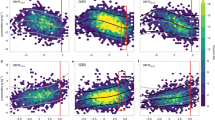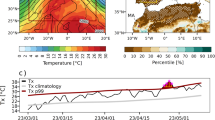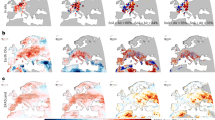Abstract
Climate change is expected to affect not only the means of climatic variables, but also their variabilities1,2 and extremes such as heat waves2,3,4,5,6. In particular, modelling studies have postulated a possible impact of soil-moisture deficit and drought on hot extremes7,8,9,10,11. Such effects could be responsible for impending changes in the occurrence of heat waves in Europe7. Here we analyse observational indices based on measurements at 275 meteorological stations in central and southeastern Europe, and on publicly available gridded observations12. We find a relationship between soil-moisture deficit, as expressed by the standardized precipitation index13, and summer hot extremes in southeastern Europe. This relationship is stronger for the high end of the distribution of temperature extremes. We compare our results with simulations of current climate models and find that the models correctly represent the soil-moisture impacts on temperature extremes in southeastern Europe, but overestimate them in central Europe. Given the memory associated with soil moisture storage, our findings may help with climate-change-adaptation measures, such as early-warning and prediction tools for extreme heat waves.
This is a preview of subscription content, access via your institution
Access options
Subscribe to this journal
Receive 12 print issues and online access
$259.00 per year
only $21.58 per issue
Buy this article
- Purchase on Springer Link
- Instant access to full article PDF
Prices may be subject to local taxes which are calculated during checkout



Similar content being viewed by others
References
Katz, R. W. & Brown, B. G. Extreme events in a changing climate: Variability is more important than averages. Clim. Change 21, 289–302 (1992).
Schär, C. et al. The role of increasing temperature variability in European summer heatwaves. Nature 427, 332–336 (2004).
Meehl, G. A. & Tebaldi, C. More intense, more frequent, and longer lasting heat waves in the 21st century. Science 305, 994–997 (2004).
Alexander, L. V. et al. Global observed changes in daily climate extremes of temperature and precipitation. J. Geophys. Res. 111, D05109 (2006).
Tebaldi, C., Hayhoe, K., Arblaster, J. M. & Meehl, G. A. Going to the extremes. An intercomparison of model-simulated historical and future changes in extreme events. Clim. Change 79, 185–211 (2006).
Fischer, E. & Schär, C. Consistent geographical patterns of changes in high-impact European heatwaves. Nature Geosci. 3, 398–403 (2010).
Seneviratne, S. I., Lüthi, D., Litschi, M. & Schär, C. Land–atmosphere coupling and climate change in Europe. Nature 443, 205–209 (2006).
Diffenbaugh, N. S., Pal, J. S., Giorgi, F. & Gao, X. Heat stress intensification in the Mediterranean climate change hotspot. Geophys. Res. Lett. 34, L11706 (2007).
Vautard, R. et al. Summertime European heat and drought waves induced by wintertime Mediterranean rainfall deficit. Geophys. Res. Lett. 34, L07711 (2007).
Fischer, E. M., Seneviratne, S. I., Vidale, P. L., Lüthi, D. & Schär, C. Soil moisture–atmosphere interactions during the 2003 European summer heatwave. J. Clim. 20, 5081–5099 (2007).
Jaeger, E. B. & Seneviratne, S. I. The role of land–atmosphere coupling for European temperature and precipitation extremes and trends. Clim. Dyn. published online 10.1007/s00382–010–0780–8 (2010).
Haylock, M. R. et al. A European daily high-resolution gridded dataset of surface temperature and precipitation for 1950–2006. J. Geophys. Res. 113, D20119 (2008).
McKee, T. B., Doesken, N. J. & Kleist, J. The Relationship of Drought Frequency and Duration to Timescales. (Eighth Conference on Applied Climatology, 1993).
Klein Tank, A. M. G. & Können, G. P. Trends in indices of daily temperature and precipitation extremes in Europe, 1946–99. J. Clim. 16, 3665–3680 (2003).
Moberg, A. & Jones, P. D. Trends in indices for extremes in daily temperature and precipitation in central and western Europe, 1901–99. Int. J. Climatol. 25, 1149–1171 (2005).
Della-Marta, P. M., Haylock, M. R., Luterbacher, J. & Wanner, H. Doubled length of western European summer heat waves since 1880. J. Geophys. Res. 112, D15103 (2007).
Kuglitsch, F. G. et al. Heat wave changes in the eastern Mediterranean since 1960. Geophys. Res. Lett. 37, L04802 (2010).
Clark, R. T., Brown, S. J. & Murphy, J. M. Modeling northern hemisphere summer heat extreme changes and their uncertainties using a physics ensemble of climate sensitivity experiments. J. Clim. 19, 4418–4435 (2006).
Koenker, R. & Bassett, G. Jr Regression quantiles. Econometrica 46, 33–50 (1978).
Koenker, R. Quantile Regression (Cambridge Univ. Press, 2005).
Cade, B. S. & Noon, B. R. A gentle introduction to quantile regression for ecologists. Front. Ecol. Environ. 1, 412–420 (2003).
Barbosa, S. M. Quantile trends in Baltic sea level. Geophys. Res. Lett. 35, L22704 (2008).
Heim, R. R. A review of twentieth-century drought indices used in the United States. B. Am. Meteorol. Soc. 83, 1149–1165 (2002).
Lloyd-Hughes, B. & Saunders, M. A. A drought climatology for Europe. Int. J. Climatol. 22, 1571–1592 (2002).
Koster, R. D. et al. Regions of strong coupling between soil moisture and precipitation. Science 305, 1138–1140 (2004).
Teuling, A. J. et al. A regional perspective on trends in continental evaporation. Geophys. Res. Lett. 36, L02404 (2009).
Seneviratne, S. I. et al. Investigating soil moisture–climate interactions in a changing climate: A review. Earth Sci. Rev. 99, 125–161 (2010).
Koster, R. D. et al. Contribution of land surface initialization to subseasonal forecast skill: First results from a multi-model experiment. Geophys. Res. Lett. 37, L02402 (2010).
Baldocchi, D. et al. FLUXNET: A new tool to study the temporal and spatial variability of ecosystem-scale carbon dioxide, water vapor, and energy flux densities. B. Am. Meteorol. Soc. 82, 2415–2434 (2001).
Dirmeyer, P. A. et al. GSWP-2: Multimodel analysis and implications for our perception of the land surface. B. Am. Meteorol. Soc. 87, 1381–1397 (2006).
Acknowledgements
We acknowledge the E-Obs dataset from the EU-FP6 project ENSEMBLES (http://www.ensembles-eu.org) and the data providers in the ECA &D project (http://eca.knmi.nl). Station observations for Austria were kindly provided by the Central Institute for Meteorology and Geodynamics (ZAMG). Moreover, we would like to thank the ENSEMBLES community for providing model data. This study was conducted in the framework of the European Commission FP6 STREP project CECILIA (contract GOCE 037005; http://www.cecilia-eu.org/). We further acknowledge support from the Swiss National Science Foundation (NCCR Climate, NRP DROUGHT-CH), the EC FP7 Project CARBO-Extreme (FP7-ENV-2008-1-226701), and the CCES MAIOLICA project.
Author information
Authors and Affiliations
Contributions
M.H. and S.I.S. designed the study and wrote the manuscript. M.H. carried out the analyses. B.O. helped with the statistical analyses. F.B., M.H., P.S., O.B.C. and S.I.S. developed the CECILIA climate and extreme database and the software code for the index calculation. V.A., C.B., H.F. and P.S. provided the observational indices. F.B. helped with the computation of the indices for the ENSEMBLES models.
Corresponding authors
Ethics declarations
Competing interests
The authors declare no competing financial interests.
Supplementary information
Supplementary Information
Supplementary Information (PDF 1012 kb)
Rights and permissions
About this article
Cite this article
Hirschi, M., Seneviratne, S., Alexandrov, V. et al. Observational evidence for soil-moisture impact on hot extremes in southeastern Europe. Nature Geosci 4, 17–21 (2011). https://doi.org/10.1038/ngeo1032
Received:
Accepted:
Published:
Issue Date:
DOI: https://doi.org/10.1038/ngeo1032
This article is cited by
-
Investigating the typicality of the dynamics leading to extreme temperatures in the IPSL-CM6A-LR model
Climate Dynamics (2024)
-
Analysis, characterization, prediction, and attribution of extreme atmospheric events with machine learning and deep learning techniques: a review
Theoretical and Applied Climatology (2024)
-
Inter-seasonal connection of typical European heatwave patterns to soil moisture
npj Climate and Atmospheric Science (2023)
-
Chinese Soil Moisture Observation Network and Time Series Data Set for High Resolution Satellite Applications
Scientific Data (2023)
-
Soil moisture-evaporation coupling shifts into new gears under increasing CO2
Nature Communications (2023)



